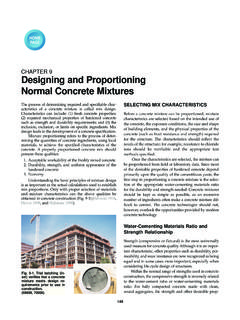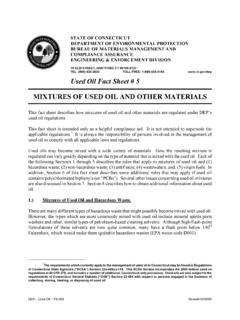Transcription of Comparing Compounds and Mixtures - …
1 Laboratory Investigation Name _____. Chemistry: Form Date _____ Period _____. Comparing Compounds and Mixtures PROBLEM. What happens to the properties of elements when they combine chemically? INTRODUCTION. Iron and sulfur are elements. They have properties that can be used for identification. Sulfur is a yellow solid. Iron is a gray solid. What happens to these properties when sulfur and iron are mixed? What happens to these properties when sulfur and iron combine chemically? In this laboratory investigation, you will examine the properties of sulfur and iron. Then you will mix sulfur and iron and examine the properties of the mixture. Finally, you will combine sulfur and iron to form a compound and examine the properties again. MATERIALS (per group). Aluminum foil; beakers (3); Bunsen burner; evaporating dish; iron; iron sulfide; magnet;. paper towel; safety goggles; scoop; striker; sulfur; test tube; test tube holder PROCEDURE.
2 1. Using a scoop, put a small amount of iron filings in a beaker. Examine the iron filings. Note the color of iron. Observe whether iron is a solid, liquid, or gas. Wrap one end of a magnet in a paper towel and dip it into the iron filings. Record your observations in the data table on the next page. 2. Using a scoop, put a small amount of sulfur in a beaker. Examine the sulfur. Note the color of sulfur. Observe whether sulfur is a solid, liquid, or gas. Wrap one end of a magnet in a paper towel and dip it into the sulfur. Record your observations in the data table on the next page. 3. Mix the contents of the two beakers. Examine the mixture. Note the color of mixture. Observe whether mixture is a solid, liquid, or gas. Wrap one end of a magnet in a paper towel and dip it into the mixture. Record your observations in the data table on the next page. 4. Put on safety goggles.
3 Using a striker, light your Bunsen burner. CAUTION: Use care when working with fire. Never reach over an open flame. 5. Using scissors, cut a piece of aluminum foil about 10. cm by 10 cm. Line the inside of an evaporating dish with a piece of aluminum foil, and set it aside for use later. 6. Using a scoop, transfer a small amount of the mixture to a test tube. With a test tube holder, carefully hold the bottom of the test tube in the flame moving it back and forth slowly until the color of the mixture changes. CAUTION: Never point the mouth of a test tube toward anybody while heating. Point the mouth of the test tube downward over the evaporating dish while heating. 7. As the color changes, the contents of the test tube melt. Allow the liquid that forms to spill into the evaporating dish lined with aluminum foil. 8. Allow the new compound to cool. Compare its appearance to iron sulfide.
4 Note the color of compound . Observe whether compound is a solid, liquid, or gas. Wrap one end of a magnet in a paper towel and dip it into the compound . Record your observations in the data table below. OBSERVATIONS. Material Description Response to Magnet Iron Sulfur Mixture compound CONCLUSIONS. 1. How do the properties of the individual elements compare to the properties of the mixture? Give examples to support your answer. 2. How do the properties of the individual elements compare to the properties of the compound ? Give examples to support your answer. 3. What happens to the properties of elements when they combine chemically? 4. How would you determine if some material containing iron was a compound of iron or a mixture with iron in it? Evan P. Silberstein, 2002.








